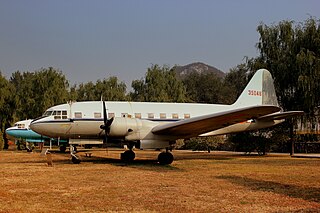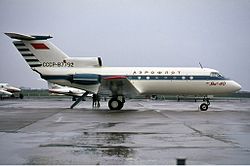
The Tupolev Tu-104 is a medium-range, narrow-body, twin turbojet-powered Soviet airliner. It was the second to enter regular service, behind the British de Havilland Comet and was the only jetliner operating in the world from 1956 to 1958, when the British jetliner was grounded due to safety concerns.

The Yakovlev Yak-42 is a 100/120-seat three-engined mid-range passenger jet developed in the mid 1970s to replace the technically obsolete Tupolev Tu-134. It was the first airliner produced in the Soviet Union to be powered by modern high-bypass turbofan engines.

The Antonov An-10 Ukraina is a four-engined turboprop passenger transport aircraft designed in the Soviet Union.

The Ilyushin Il-12 is a Soviet twin-engine cargo aircraft, developed in the mid-1940s for small and medium-haul airline routes and as a military transport.
Aviaarktika was a Soviet airline which started operations on 1 September 1930 and was absorbed by Aeroflot on 3 January 1960.

Aeroflot Flight U-505 crashed just after takeoff in Tashkent on 16 January 1987. Flight 505 was an early morning flight from Tashkent to Shahrisabz, both in the Uzbek Soviet Socialist Republic, now the Republic of Uzbekistan. The flight took off just one minute and 28 seconds after an Ilyushin Il-76, thus encountering its wake vortex. The Yakovlev Yak-40 then banked sharply to the right, struck the ground, and caught fire. All 9 people on board died.

Aeroflot Flight 3932 was a flight operated by Aeroflot from Sverdlovsk-Koltsovo to Omsk Tsentralny Airport. On 30 September 1973, the Tupolev Tu-104 operating the route crashed shortly after takeoff from Sverdlovsk, killing all 108 passengers and crew on board.

Aeroflot Flight 2230 was a Soviet domestic passenger flight from Yekaterinburg to Tashkent. On 16 November 1967, the Ilyushin Il-18 aircraft serving the flight crashed after takeoff, killing all 107 people aboard. At the time, it was the deadliest aviation accident in the Russian SFSR and the worst accident involving the Il-18.

Aeroflot Flight 6502 was a Soviet domestic passenger flight operated by a Tupolev Tu-134A from Sverdlovsk to Grozny via Kuibyshev, which crashed in Kuibyshev on 20 October 1986. Seventy of the 94 passengers and crew on board were killed when the plane overran the runway, after the pilot made a bet that he could make an instrument-only approach with curtained cockpit windows. Investigators determined the cause of the accident was pilot negligence.

The Antonov An-12 is a transport aircraft designed and manufactured by the Ukrainian manufacturing and services company Antonov. Given the long operational history of the An-12, more than 190 An-12s have crashed involving many casualties. The An-12 has also been involved in a number of aviation incidents.

Aeroflot Flight 513 was a domestic scheduled passenger flight operated by Aeroflot that crashed during takeoff from Kuybyshev Airport in the Soviet Union on 8 March 1965, resulting in the deaths of 30 passengers and crew. It was the first fatal accident involving a Tupolev Tu-124.

Aeroflot Flight 5003 was a Soviet domestic cargo flight that crashed during climb out on 14 January 1967. The Antonov An-12B was flying between Novosibirsk and Krasnoyarsk in Russia with a crew of six when it crashed. It was carrying industrial parts from Moscow to Khabarovsk with several intermediate stops in between, however it caught fire shortly after takeoff, resulting in a fatal accident. At the time Flight 5003 was being operated by Polar Aviation Management under Aeroflot.

Aeroflot Flight 068 was a regularly scheduled passenger flight operated by Aeroflot from Khabarovsk Novy Airport in Khabarovsk Krai to Pulkovo Airport in Saint Petersburg with intermediate stops at Tolmachevo Airport in Ob, Russia, then Koltsovo Airport in Yekaterinburg. On 16 March 1961, the Tupolev Tu-104B operating this flight crashed shortly after take off from Koltsovo Airport due to engine failure. Two crewmembers and 3 passengers along with two people on the ground, perished.

The 1981 Zheleznogorsk mid-air collision was an accident involving a Yakovlev Yak-40 jet and a Mil Mi-8T helicopter, both operated by the Russian airline Aeroflot, 11 km east of Zheleznogorsk-Ilimskiy Airport, Soviet Union, on 18 September 1981. None of the combined 40 passengers and crew on either aircraft survived.

Aeroflot Flight 29674 was a non-scheduled passenger flight from Nizhnevartosk to Bugulma, with a stopover at Tyumen. On January 24, 1988, the Yakovlev Yak-40 operating the flight, crashed after an engine failure caused by unknown causes, crashing near Nizhnevartosk Airport, killing 27 out of the 31 occupants onboard.














